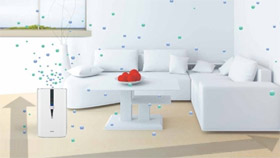If you’re looking to introduce a little extra freshness and a healthier environment into your house by purifying the air, you get the difficult task of choosing just the right purifier for you. Air purifiers come in all shapes and sizes and utilize different technologies. And if that’s not enough, they all come with enough accessories and equipment to make your head spin! But don’t worry, I’ve done the hard part for you.
You might be asking yourself what an air purifier actually does, or how it functions. To know whether you are on the right path, keep reading my buying guide so you know what to look for as well as what to run away from!

Filter Type
Every filter technology has the same goal and that’s to filter the air of dust, pollen, odors, smoke and other dangerous pollutants. Of course, cleaning the air requires a certain technology, and there are five types of air cleaning technologies you can choose from.
- Mechanical filtering
- Ion generators
- UV filtration
- Electrostatic air cleaners
- hybrid systems
One of the most famous mechanical filters is the HEPA True filter which is very successful at trapping airborne particles that might cause harm and spread disease. They are extremely efficient at capturing and removing dust, dust mites, pollen, and pet dander. The best thing to remember is to look for a HEPA True model which is guaranteed to remove 99.9% of pollutants.
I will discuss the ionic, UV and electrostatic filtration methods on a seperate page but what you should also know is that the existence of a pre-filter adds to a purifier’s efficiency is. Whether washable or replaceable, it prolongs the life of your main filter. And if the pre-filter in question is activated carbon your air cleaning unit will be better at removing smoke and odors.
Air Change Rate
The ACH (or the air change per hour rate) tells you exactly how many times the unit cleans the entire room’s air during one hour. Therefore, if you find an air purifier that has 5 ACH this means the air will be cleaned every twelve minutes.
What you should know is that the advertised ACH rate usually means the rate at the maximum operating speed and the maximum room size. So if you like your air purifier to be quiet and don’t want to run it at maximum speeds all the time, it’s wise to oversize by, say, 20-40%.
CADR Ratings
There’s more on this subject here, but in short the Association of Home Appliance Manufacturers developed the CADR, otherwise known as the Clean Air Delivery Rate. This helps you identify how quick and efficient your potential air cleaner is. It figures out how many cubic feet of air the unit can filter in one minute. There are numbers for each of the three most important categories dust, pollen, and smoke.
The higher the number the faster the purifier filters the air. Look for air cleaners that have higher CADR ratings if you have a large space that requires constant air cleaning. If you don’t find an air purifier with sufficiently high numbers, you can always move the air purifier around to get equally clean and fresh air in all corners of the space.
Room Size
 When choosing the right air cleaner for you, take into consideration the size of your household or office and the size of your air purifier. There are models that take up a lot of space, as opposed to those that are compact and portable.
When choosing the right air cleaner for you, take into consideration the size of your household or office and the size of your air purifier. There are models that take up a lot of space, as opposed to those that are compact and portable.
Whilst room size is important, you should also think about how well the air will be filtered. With the risk of repeating myself, you should always get a model that is made for operating in a slightly larger space than yours actually is. This is going to guarantee you clean and fresh air all the way.
Sensor Technology and Indicators
This might not be crucial but still comes in handy. Many air purifier manufacturers have taken the next step in creating units that automatically adjust the speed of the fans, meaning if the air quality drops it will automatically begin to filter the air in order to clean it faster.
Another useful thing that could save you time and money are light indicators that tell you when to replace or clean your filters. This will save you money in the sense that you won’t replace your filters prematurely.
Conclusion
So there you have it, my buying guide on air purifiers. What I will say is this page has been termed a “guide” for a reason. I’m not here to sway your decision in any way, just to help you with your decision making process. What you always want to keep in mind is that the purpose of purifiers is to clean the air of dangerous particles and give you a healthy and comfortable environment, and the guidelines above will at least help you in achieving just that!
